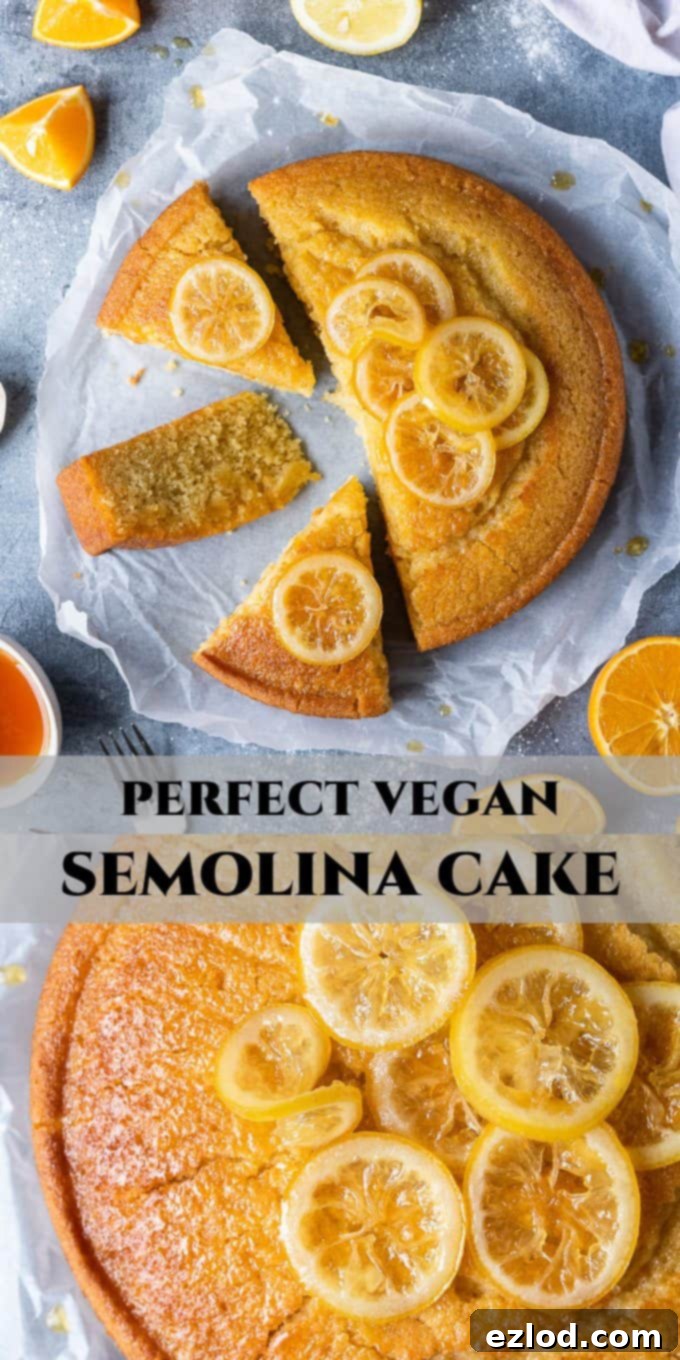Deliciously Moist & Easy Vegan Semolina Cake: Your Ultimate Eggless & Dairy-Free Citrus Treat
Discover the joy of baking with this incredible vegan semolina cake – a perfect eggless and dairy-free delight. Whether you prefer it plain or infused with vibrant orange and lemon, its moist, tender, and melt-in-your-mouth texture is simply irresistible. Ideal as a tea-time treat, a satisfying snack, or served warm with creamy custard or ice cream for an exquisite dessert!

Welcome to your new favorite recipe: an incredibly easy, one-bowl vegan citrus semolina cake that promises to become a staple in your kitchen. This delightful creation is not only simple to prepare but also versatile enough for any occasion. Imagine a slice of this moist, tender cake alongside your afternoon tea or coffee – it’s the ultimate treat for a quiet moment or a gathering with friends.
Beyond being a fantastic snack, this cake transforms into a luxurious dessert when served warm. Pair it with generous dollops of dairy-free custard or a scoop of your favorite vegan ice cream for an indulgent experience that’s sure to impress.
The beauty of this semolina cake lies in its delicate, tender crumb and its light, refreshing citrus flavour. I personally love the combination of orange and lemon zest to create a bright, uplifting taste, but you have the freedom to choose. Stick to just orange or just lemon, or for a classic, comforting treat, omit the citrus entirely and let pure vanilla take the spotlight for a simple yet elegant vegan semolina cake.

Why Choose Semolina for Your Vegan Cake?
Semolina, a coarsely ground durum wheat, might not be the first ingredient that comes to mind for cake, but it’s truly a star in vegan baking. Its unique texture lends itself to an incredibly moist and tender crumb that’s distinct from traditional flour-based cakes. Semolina absorbs liquids beautifully, which is key to achieving that desirable “melt-in-your-mouth” quality without the need for eggs or dairy. It also imparts a subtle, slightly grainy texture that adds depth and a pleasant chewiness, making for a cake that feels both comforting and sophisticated.
For those exploring eggless and dairy-free recipes, semolina is a fantastic choice as it naturally provides structure and moisture, mimicking some of the functions of eggs and dairy in conventional baking. This makes it an ideal ingredient for creating robust, flavorful vegan desserts that don’t compromise on texture or taste.
Crafting Your Perfect Vegan Semolina Cake: A Step-by-Step Guide
This recipe is designed for simplicity, making it accessible even for novice bakers. The “one-bowl” approach minimizes washing up and streamlines the process, so you can spend less time cleaning and more time enjoying your delicious creation.
Ingredients Overview: Building Blocks for a Delicious Cake
- Fine Semolina: The star of our show, providing unique texture and moisture.
- Plain Flour: Balances the semolina and adds structure.
- Caster Sugar & Salt: For sweetness and to enhance overall flavor.
- Olive Oil: Contributes richness and moisture without dairy. You can also use sunflower, vegetable, or canola oil, or even melted coconut oil or vegan block butter for a different flavor profile.
- Non-Dairy Yogurt & Milk: Essential for a tender, moist crumb in vegan baking. Coconut Collaborative yogurt and soy milk are my go-to choices for excellent results.
- Vanilla Extract & Orange Blossom Water: For aromatic depth and an optional floral note.
- Orange & Lemon Zest: The secret to that bright, invigorating citrus flavor.
- Baking Powder & Bicarbonate of Soda: Our trusty leavening agents that ensure a beautiful rise.
The Essential Soaking Step: What You Need to Know
The key to this cake’s incredible texture is the soaking process. After combining your dry ingredients (semolina, flour, salt, sugar) with the wet ingredients (oil, yogurt, milk, vanilla, optional orange blossom water and zest), it’s crucial to whisk everything until smooth and then set it aside to soak for a full 30 minutes. This resting period allows the fine semolina to fully hydrate, preventing a gritty texture and ensuring your cake turns out wonderfully moist and tender. It’s a simple step that makes a world of difference, transforming the batter into a luxurious, slightly thickened consistency.
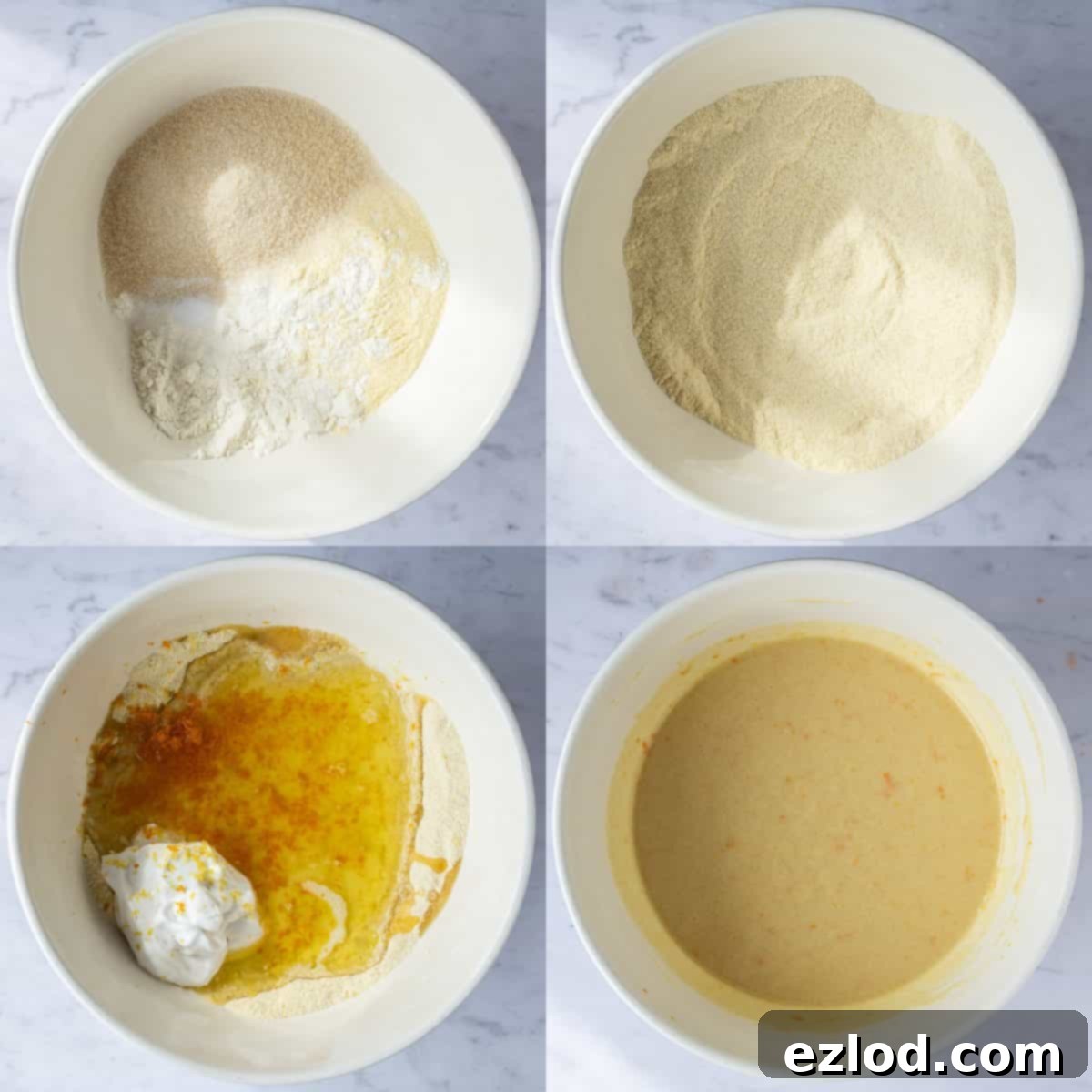
Prepping for Perfection: Oven and Tin Setup
While your batter is soaking, seize the opportunity to prepare your baking environment. Preheat your oven to 180°C/350°F/gas mark 4. This ensures the oven is at the correct temperature when your batter is ready, allowing for even baking. Next, grease a 20cm/8in round, 5cm/2in deep cake tin. A loose-bottomed tin is highly recommended for easy removal. Line the bottom with baking parchment to prevent sticking and ensure a perfect release.
Activating the Rise: The Importance of Timing
Once the 30-minute soaking period is complete, you’ll notice the batter has thickened slightly. Now is the time to add your leavening agents: baking powder and bicarbonate of soda (baking soda). Sprinkle them evenly over the batter and whisk gently but thoroughly to combine. Be careful not to overbeat at this stage; simply mix until the raising agents are fully incorporated. Adding them too early, before the semolina has soaked, can result in a flat cake, as their leavening power would be spent during the resting period.
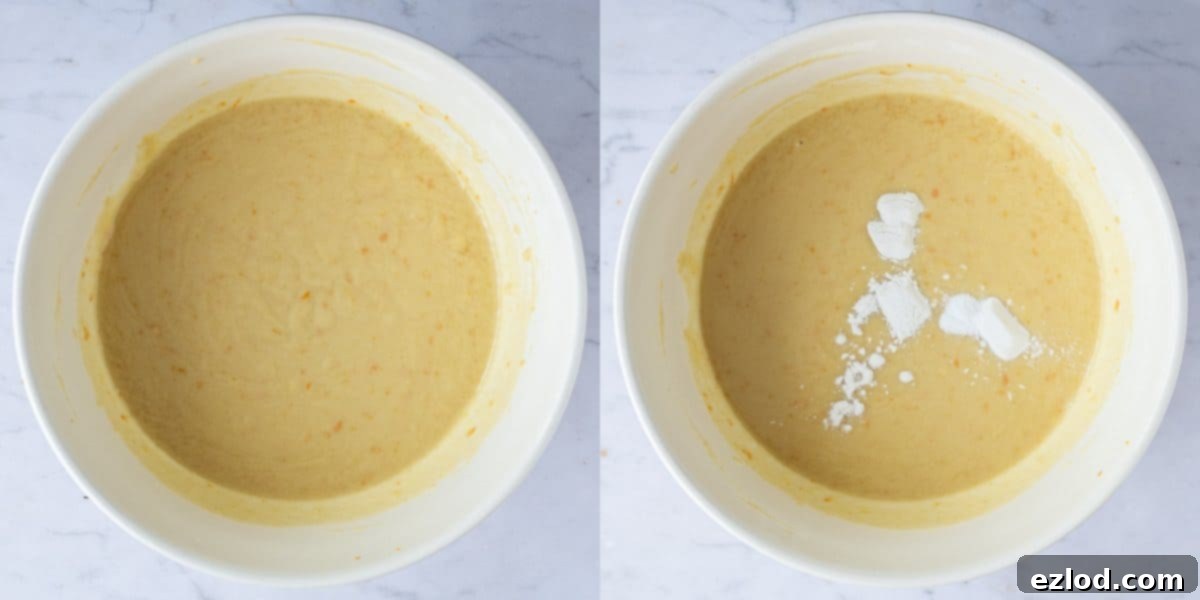
Baking to Golden Perfection
Pour the prepared batter into your lined cake tin and gently spread it out to create an even layer. Bake for approximately 35 minutes. You’ll know it’s ready when the cake feels firm to the touch in the center, and a skewer inserted into the middle comes out clean or with only a few moist crumbs clinging to it – no wet batter. This indicates a perfectly cooked interior, ensuring a moist cake without being underbaked.
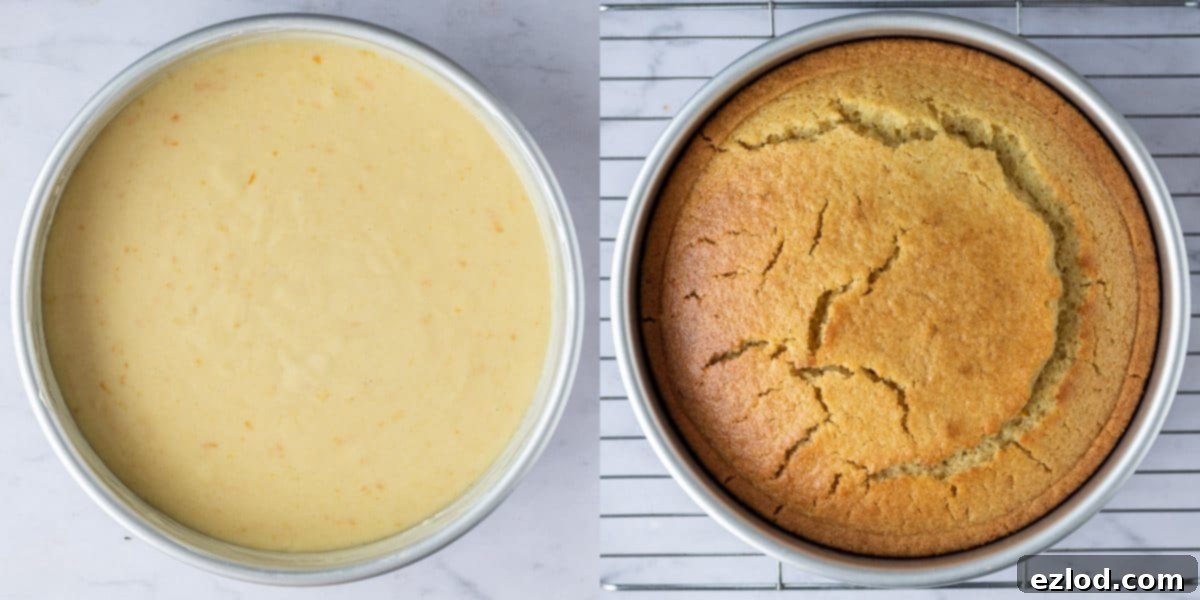
The Optional, Yet Recommended, Syrup
While the cake bakes, prepare the optional syrup. This simple syrup adds an extra layer of flavour and, more importantly, keeps the cake incredibly moist. In a jug, combine the juice of an orange and/or lemon. Measure out 80ml (⅓ cup) and pour it into a small saucepan. Add the granulated or caster sugar and place the pan over a low heat. Stir continuously until the sugar has fully dissolved. Once dissolved, bring the mixture to a gentle simmer for just one minute, then remove it from the heat. This quick simmer ensures the syrup thickens slightly and properly infuses the cake.
Infusing the Cake with Syrup
As soon as the cake emerges from the oven, while it’s still warm, grab a skewer and poke holes all over the top surface. This creates channels for the syrup to penetrate deeply into the cake. Drizzle the warm syrup evenly over the entire cake, ensuring every part gets its share of the flavorful moisture. Avoid pouring all the syrup into the center, as this can make one area overly soggy. If you’re not using a loose-bottomed tin, you might find it easier to carefully turn the cake out onto a wire rack before adding the syrup, as a warm, syrup-soaked cake can be quite delicate and prone to breaking if handled too much.
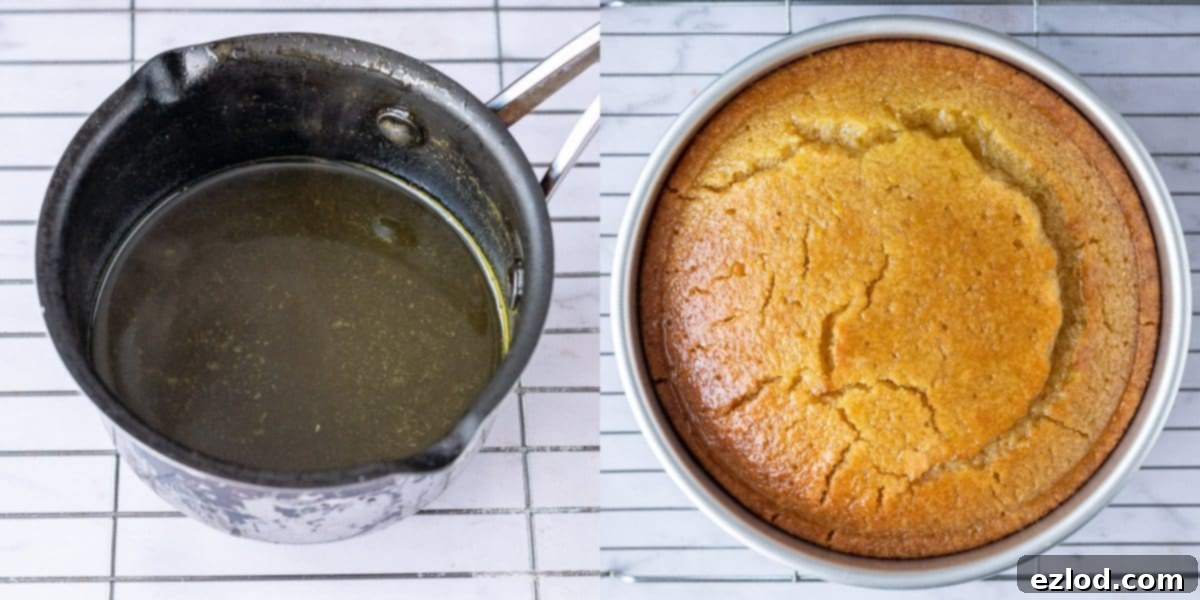
Cooling and Enjoying Your Masterpiece
Allow the cake to cool in its tin for about 15 minutes, giving the syrup ample time to soak in completely and settle. This patience will be rewarded. After 15 minutes, carefully invert the cake onto a wire rack and let it cool down entirely. This gradual cooling process helps the cake retain its moisture and firm up, making it easier to slice and serve. Once cool, your delectable vegan semolina cake is ready to be enjoyed!
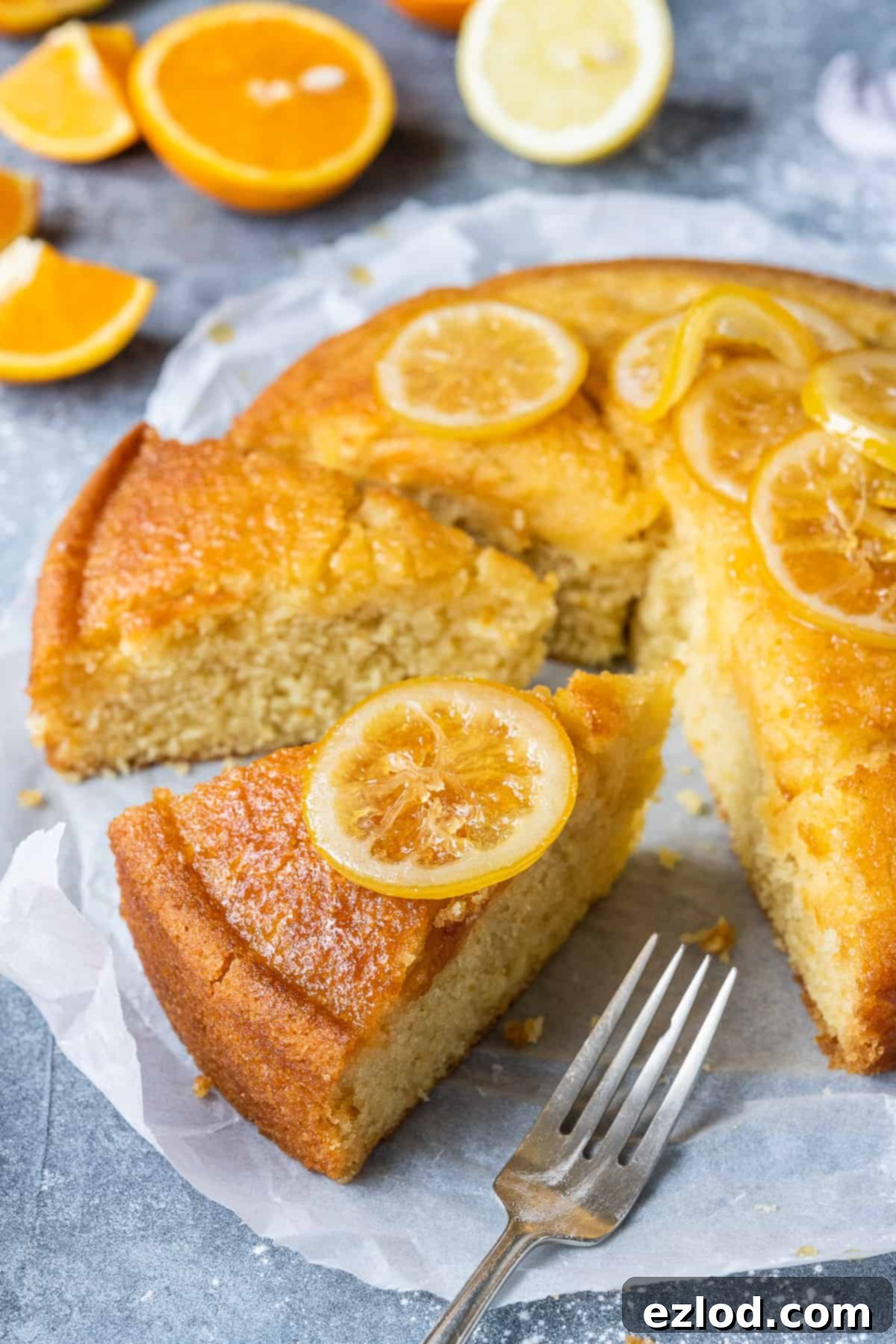
Top Tips for Vegan Semolina Cake Success:
- Precision is Key: For consistently perfect results, I strongly advocate for using gram measurements with a digital kitchen scale over cup conversions. Cup measurements can be notoriously inaccurate in baking, and precision ensures your cake turns out exactly as intended.
- Semolina Type: This recipe calls for fine semolina. If coarse semolina is all you have on hand, don’t fret! Simply pulse it a few times in a blender or food processor until it reaches a finer consistency. This ensures the best texture for your cake.
- Oil Alternatives: While olive oil lends a lovely subtle flavor, feel free to substitute with other neutral oils like sunflower, vegetable, or canola oil. Melted coconut oil or a good quality vegan block butter/margarine can also be used for different flavor profiles and richness.
- The Soaking Secret: Do NOT skip the 30-minute soaking period for the batter. This step is crucial for hydrating the semolina, resulting in a wonderfully moist cake with a smooth, non-gritty texture. Remember, only add the baking powder and bicarbonate of soda *after* the batter has soaked. Adding them too early will cause their leavening power to dissipate, and your cake may not rise properly.
- Syrup’s Role: Although optional, the citrus syrup is highly recommended. It not only infuses the cake with additional flavor but also significantly enhances its moisture content, keeping it fresh and delicious for longer.
Storing Your Vegan Semolina Cake:
This cake keeps beautifully! Store any leftovers in an airtight container at room temperature for up to 5 days. This will maintain its delicious moistness and flavor.
Can You Freeze Vegan Semolina Cake?:
Absolutely! This vegan semolina cake is freezer-friendly, making it perfect for meal prep or enjoying a slice whenever a craving strikes. You can freeze it either whole or in individual slices. Wrap it tightly in plastic wrap, then place it in a ziplock bag or a freezer-safe container. It will keep well in the freezer for up to 3 months. When you’re ready to enjoy, simply allow it to defrost at room temperature.

How to Make Beautiful Candied Lemon or Orange Slices:
While entirely optional, homemade candied lemon or orange slices add a touch of elegance and a burst of intense citrus flavor to your cake. They’re surprisingly simple to make and elevate the presentation significantly.
- Prepare the Syrup: In a medium-small saucepan, combine 150g granulated sugar with 200ml water. Stir over a low heat until the sugar has fully dissolved, creating a clear syrup.
- Slice the Citrus: Thinly slice 1-2 lemons, 1-2 oranges, or a combination of one orange and one lemon. Aim for uniform slices about 2-3mm thick.
- Simmer to Perfection: Gently lay the citrus slices in a single layer within the sugar syrup. Bring the pan to a very gentle simmer and cook for approximately 30-45 minutes. The slices should become soft and almost translucent, indicating they’ve absorbed the syrup beautifully. Remember to carefully flip them halfway through the cooking process to ensure even candying.
- Dry and Decorate: Once candied, carefully remove the slices from the syrup and lay them out on a sheet of baking parchment. Allow them to dry at room temperature for an hour or two until they are slightly tacky but not wet. For the best visual appeal and texture, place them on your cooled cake shortly before serving. They add a vibrant pop of color and a delightful sweet-tart chewiness.
Frequently Asked Questions (FAQ)
Q: Can I use coarse semolina directly?
A: While fine semolina is preferred for a smoother texture, you can use coarse semolina by pulsing it a few times in a blender or food processor to grind it into a finer consistency before measuring and adding to the recipe.
Q: What non-dairy yogurt and milk do you recommend?
A: I’ve had great success with coconut-based yogurts (like Coconut Collaborative) and unsweetened soy milk. However, feel free to experiment with other plain, unsweetened non-dairy yogurts (almond, oat) and milks (almond, oat) you prefer. Ensure they are plain and unsweetened to control the cake’s sweetness.
Q: Can I make this cake without the citrus zest or syrup?
A: Yes, absolutely! For a plain vanilla semolina cake, simply omit the citrus zest. The syrup is also optional, but it significantly enhances the cake’s moisture and flavor, so it’s highly recommended if you desire a truly decadent result.
Q: My cake didn’t rise much, what went wrong?
A: The most common reason for a flat semolina cake is adding the baking powder and bicarbonate of soda before the 30-minute soaking period. These leavening agents need to be added just before baking to be effective. Ensure your leavening agents are fresh, as expired baking powder/soda will not activate properly.
Q: How long does it take for the candied fruit slices to dry?
A: Drying time can vary depending on humidity and how thinly they are sliced, but generally, 1 to 2 hours at room temperature on baking parchment is sufficient. They should feel slightly firm and less sticky, but not brittle.
More Simple Vegan Cake Recipes to Explore:
If you loved this vegan semolina cake, you might enjoy these other delightful vegan baking recipes from Domestic Gothess:
- Easy Vegan Banana Bread
- Vegan Apple Cake
- Vegan Pumpkin Bread
- Ultimate Vegan Lemon Drizzle Cake
- Lemon Blueberry Polenta Cake
- Vegan Courgette Cake
- Vegan Mango Bundt Cake
- Vegan Carrot Cake Loaf
- Easy Vegan Chocolate Cake
- Easy Vegan Ginger Cake

If you tried this delightful recipe, we’d love to see your creation! Tag @domestic_gothess on Instagram and use the hashtag #domesticgothess to share your culinary success!
*All images and content on Domestic Gothess are copyright protected. If you want to share this recipe then please do so by using the share buttons provided. Do not screenshot or post the recipe or content in full.*

Print
Vegan Semolina Cake
Ingredients
- 225 g (1 ⅓ cups + 1 Tbsp) fine semolina*
- 40 g (⅓ cup) plain (all-purpose) flour
- ¼ tsp salt
- 175 g (¾ cup + 2 Tbsp) caster (superfine) sugar
- 80 ml (⅓ cup) olive oil**
- 125 g (½ cup) non-dairy yogurt (I use the Coconut Collaborative)
- 185 ml (¾ cup) unsweetened non-dairy milk (I use soy)
- 1 tsp vanilla extract
- 1 tsp orange blossom water optional
- finely grated zest of 1 orange and 1 lemon (or 2 lemons or 2 oranges) optional
- 1 ½ tsp baking powder
- ¼ tsp bicarbonate of soda (baking soda)
Syrup:
- juice of 1 small orange and 1 lemon (or 2 lemons or 2 small oranges)
- 60 g (⅓ cup) granulated or caster sugar
Instructions
-
Place the semolina, flour, salt and sugar in a large bowl and whisk to combine thoroughly.
-
Add the oil, yogurt, milk, vanilla extract, orange blossom water (if using) and citrus zest (if using). Whisk until the batter is smooth and no lumps remain, then set it aside to soak for 30 minutes. This soaking step is crucial for texture.
-
Meanwhile, preheat your oven to 180°C/350°F/gas mark 4. Prepare a 20cm/8in round, 5cm/2in deep cake tin by greasing it and lining the bottom with baking parchment. A loose-bottomed tin is highly recommended.
-
After the batter has soaked for 30 minutes, you will notice it has thickened. Sprinkle the baking powder and bicarbonate of soda evenly over the batter and whisk just enough to combine, being careful not to overmix.
-
Pour the batter into the prepared cake tin and gently spread it level with a spatula. Bake for approximately 35 minutes, or until the cake is firm to the touch in the center and a skewer inserted comes out clean (or with a few moist crumbs, but no wet batter).
-
While the cake is baking, prepare the optional syrup. Mix the orange and/or lemon juice in a jug, then measure out 80ml (⅓ cup) and pour it into a small saucepan.
-
Add the granulated or caster sugar to the saucepan and place it over a low heat. Stir continuously until the sugar has completely dissolved, then bring the mixture to a gentle simmer for about one minute. Remove from heat.
-
Once the cake is baked, immediately poke holes all over the top with a skewer. Drizzle the warm syrup evenly over the entire surface of the cake, ensuring good coverage. (If you don’t have a loose-bottomed tin, you might find it easier to carefully turn the cake out onto a wire rack before adding the syrup, as the syrup-soaked cake can be delicate.)
-
Leave the cake to cool in the tin for 15 minutes to allow the syrup to fully absorb. Then, carefully turn it out onto a wire rack and let it cool completely before slicing and serving.
Notes
- For the best results, always follow the recipe closely and use gram measurements with a digital scale rather than cup conversions, which are less precise for baking.
- *This recipe uses fine semolina. If you only have coarse semolina, you can pulse it in a blender or food processor a few times to achieve a finer consistency before using.
- **Olive oil is recommended for its flavor, but sunflower, vegetable, or canola oil can be used interchangeably. Melted coconut oil or vegan block butter/margarine are also suitable alternatives.
- The 30-minute soaking period for the batter is crucial. Do not add the baking powder and bicarbonate of soda (baking soda) until *after* the soaking is complete; this ensures the cake rises correctly and maintains a moist, non-gritty texture.
- The syrup is optional but highly recommended to enhance flavor and moisture.
- This recipe was adapted from a Rava Cake (Sooji Cake) recipe by Aromatic Essence.
